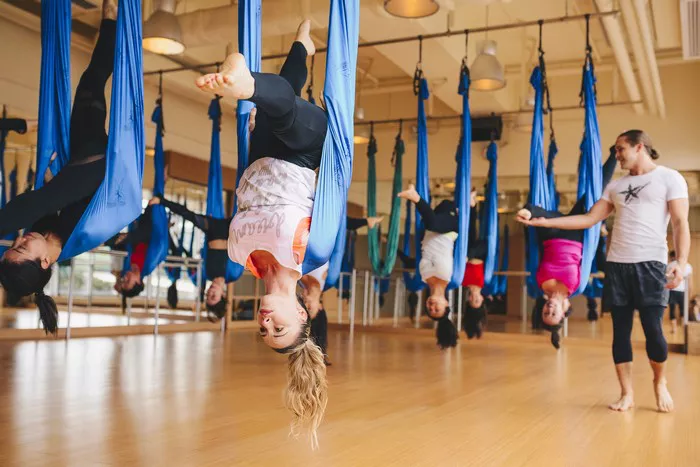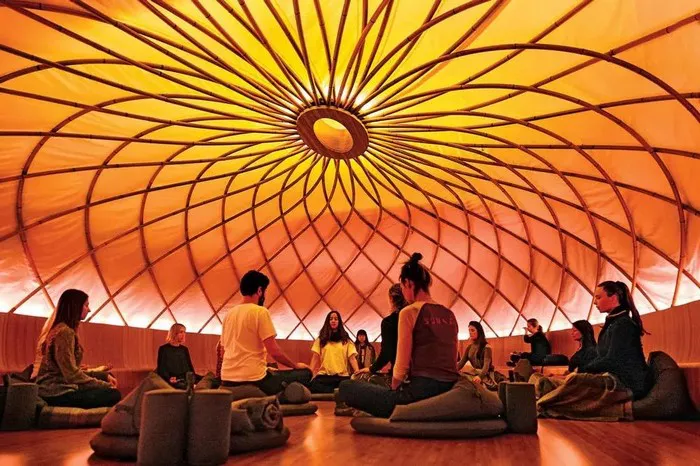Antigravity yoga, also known as aerial yoga, is a relatively new form of yoga that has gained popularity in recent years. Unlike traditional yoga, which is practiced on the ground, antigravity yoga involves performing various poses and exercises while suspended in the air using a hammock or sling. This unique approach to fitness offers a range of benefits and challenges, making it an intriguing option for those looking to expand their yoga practice or try something new.
Origins and Development
Antigravity yoga was developed by Christopher Harrison, a former gymnast and Broadway choreographer, in the early 2000s. Drawing inspiration from his background in acrobatics and dance, Harrison created a series of yoga poses that could be performed using a silk hammock suspended from the ceiling. His goal was to combine the benefits of traditional yoga with the excitement and freedom of aerial acrobatics.
Since its inception, antigravity yoga has evolved and expanded, with numerous variations and styles emerging. While Harrison’s original technique, known as AntiGravity Fitness, remains popular, other instructors and practitioners have developed their own approaches, incorporating elements of dance, Pilates, and other disciplines.
Practice and Equipment
Antigravity yoga classes typically take place in specialized studios equipped with ceiling-mounted rigging systems. Each participant is assigned their own hammock, which is adjusted to their height and weight. The hammocks are made from strong, stretchy fabric that can support the weight of a person while providing comfort and flexibility.
During a typical antigravity yoga class, participants perform a series of poses and exercises while suspended in the hammock. These may include traditional yoga poses such as downward dog and warrior, as well as more challenging moves that involve flipping, twisting, and hanging upside down. The hammock provides support and stability, allowing practitioners to explore new movements and deepen their practice.
Benefits and Challenges
One of the key benefits of antigravity yoga is its ability to decompress the spine and relieve tension in the muscles. Hanging upside down in the hammock allows gravity to gently stretch and elongate the spine, counteracting the compression that occurs during everyday activities such as sitting and standing. This can help improve posture, increase flexibility, and reduce back pain.
In addition to its physical benefits, antigravity yoga also offers mental and emotional benefits. The feeling of weightlessness and freedom that comes from being suspended in the air can be incredibly liberating, helping to release stress and promote relaxation. Many practitioners also find that the playful and adventurous nature of antigravity yoga helps to boost mood and creativity.
However, antigravity yoga is not without its challenges. While the hammock provides support, it also requires strength and coordination to use effectively. Beginners may find certain poses difficult or uncomfortable, particularly those that involve hanging upside down or balancing in mid-air. It’s important for practitioners to listen to their bodies and work at their own pace, gradually building strength and confidence over time.
Safety Considerations
As with any form of physical activity, safety is paramount when practicing antigravity yoga. It’s essential to receive proper instruction from a qualified instructor who can guide you through the poses safely and effectively. Beginners should start with introductory classes and work their way up to more advanced levels as they become more comfortable with the practice.
It’s also important to listen to your body and avoid pushing yourself too hard. While some discomfort is normal, particularly when trying new poses, pain should never be ignored. If you experience any sharp or intense pain during a class, stop immediately and inform your instructor.
Additionally, it’s crucial to ensure that the rigging system and hammocks are properly maintained and inspected regularly. Faulty equipment can pose a serious risk to practitioners, so it’s essential to practice in a studio that prioritizes safety and follows industry best practices.
Conclusion
Antigravity yoga offers a unique and exhilarating approach to fitness that combines the principles of traditional yoga with the excitement of aerial acrobatics. By practicing yoga poses while suspended in a hammock, practitioners can experience a range of physical, mental, and emotional benefits, including improved flexibility, reduced stress, and increased creativity. However, it’s essential to practice safely and responsibly, following proper instruction and listening to your body at all times. With the right guidance and mindset, antigravity yoga can be a fun and rewarding addition to any fitness routine.





















